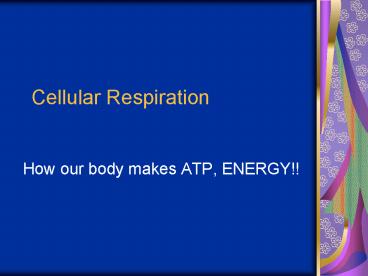Cellular Respiration - PowerPoint PPT Presentation
1 / 48
Title: Cellular Respiration
1
Cellular Respiration
- How our body makes ATP, ENERGY!!
2
Engage
- ATP Gun
- Adenosine Tri-Phosphate (ATP)
- Adenosine
- Ribose Sugar
- 3 Phosphates
3
(No Transcript)
4
ExploreCellular Respiration Simulation
- To review the "big picture" of metabolism, aiding
students in understanding the relationship among
glycolysis, the Kreb's cycle, and the ETC. See
the diagram for the simulation layout.
5
Explore
- Muscle Fatigue
- You will be using a procedure to experience and
explore lactic acid buildup in muscles.
6
ExplainWhere do our cells get energy?
- 6-C sugars are the MAJOR source of energy for
cell - What type of macromolecule are 6-C sugars?
- Carbohydrates
- Cells break down glucose a 6-C sugar to make ATP
energy
7
Overall Chemical Process
- C6H12O6 6O2 ? 6CO2 6H2O usable energy
- (ATP)
8
Cellular Respiration (3-stages)
- Glycolysis
- Krebs Cycle (Citric Acid Cycle)
- Electron Transport Chain (ETC)
Glucose
Krebs cycle
Electrontransport
Glycolysis
Fermentation (without oxygen)
Alcohol or lactic acid
9
(No Transcript)
10
Flowchart
Section 9-2
Cellular Respiration
Carbon Dioxide (CO2) Water (H2O) ATP
Glucose(C6H1206) Oxygen(02)
Glycolysis
KrebsCycle
ElectronTransportChain
11
(No Transcript)
12
Figure 93 Glycolysis
Glycolysis Step 1
Glucose
2 Pyruvic acid
To the electron transport chain
13
Figure 93 Glycolysis
Section 9-1
Glucose
2 Pyruvic acid
To the electron transport chain
14
Figure 93 Glycolysis
Section 9-1
Glucose
2 Pyruvic acid
To the electron transport chain
15
- Where? Cytoplasm
- NO O2 required
- Energy Yield? net gain of 2 ATP at the expense of
2 ATP - 6-C glucose ? TWO 3-C pyruvates
- Free e- and H combine with organic ion carriers
called NAD ? NADH H - (nicotinamide dinucleotide)
16
Summary
- In
- Glucose (6-C)
- 2 ATP
- Out
- 2 pyruvate 2(3-C)
- 2NADH
- a net of 2 ATP
17
Questions
- Where does glycolysis take place?
- Glycolysis energy yield?
- Breaks glucose into TWO ________.
18
(No Transcript)
19
The Krebs Cycle
Section 9-2
Citric Acid Production
Mitochondrion
20
Figure 96 The Krebs Cycle
Section 9-2
Citric Acid Production
Mitochondrion
21
Breakdown of Pyruvic Acid
- Where? mitochondria
- Pyruvate (3-C) ? Acetic acid (2-C)
- 3rd C forms CO2
- Acetic acid combines with Coenzyme A to form
ACETYL-CoA
22
Summary
- In
- Pyruvate
- NAD
- CoA
- Out
- CO2 (as waste)
- NADH
- Acetyl-CoA
23
What is releasing Energy with O2?
- Aerobic respiration
- Where? In mitochondria
24
Second Step Citric Acid Cycle (Krebs Cycle)
- Where? Mitochondrial matrix
- Energy Yield? 2 ATP and more e-
- Acetyl-CoA (2-C) combines with 4-C to form 6-C
CITRIC ACID - Citric Acid (6-C) changed to 5-C then to a 4-C
- Gives off a CO2 molecule
- NAD and FAD pick up the released e-
- FAD becomes FADH2
- NAD becomes NADH H
- Cycle ALWAYS reforming a 4-C molecule
25
Krebs Cycle
26
The Krebs Cycle
Section 9-2
Citric Acid Production
Mitochondrion
27
Figure 96 The Krebs Cycle
Section 9-2
Citric Acid Production
Mitochondrion
28
ETC
- Where? inner membrane of mitochondria
- Energy Yield? Total of 32 ATP
- O2 combines with TWO H to form H2O
- Exhale - CO2, H2O comes from cellular respiration
29
Electron Transport Chain
Section 9-2
Electron Transport
Hydrogen Ion Movement
Channel
Mitochondrion
Intermembrane Space
ATP synthase
Inner Membrane
Matrix
ATP Production
30
Summary
31
Total ENERGY Yield
- Glycolysis? 2 ATP
- Krebs Cycle? 2 ATP
- ETC ? 32 ATP
- Total? 36 ATP
32
Elaboration
- Respiration Lab
- Three experiments that review and further explain
the process of cellular respiration
33
What happens if NO O2?
- Cellular respiration process STOPS
34
Aerobic vs. Anaerobic
- Anaerobic DOES NOT require oxygen
- Simple
- fast
- produces smaller amounts of energy (ATP)
- Aerobic requires oxygen
- Yields large amounts of energy
- What is this energy molecule?
- ATP, ATP, ATP
35
(No Transcript)
36
Releasing Energy w/out Oxygen
- Anaerobic Respiration
- NO Additional ATP is Formed
- NO O2 leads to Fermentation
- Two Types
- Lactic Acid Fermentation
- Alcoholic Fermentation
37
Lactic Acid Fermentation
- bacteria, plants and most animals
- After glycolysis?
- 2 pyruvic acid changed to lactic acid
- Sometimes happens in your muscles,
cramps-----Exercise
38
(No Transcript)
39
Alcoholic Fermentation
- Bacteria and fungi (yeast)
- Ethyl alcohol and carbon dioxide are the end
products - Process used to form beer, wine, and other
alcoholic beverages - Also used to raise dough, bread
40
(No Transcript)
41
Cellular Respiration Review
- Three Main Stages
- Glycolysis (2 ATP)
- Krebs Cycle (2 ATP)
- Electron Transport Chain (32 ATP)
42
Figure 93 Glycolysis
Glycolysis Step 1
Glucose
2 Pyruvic acid
To the electron transport chain
43
Figure 93 Glycolysis
Section 9-1
Glucose
2 Pyruvic acid
To the electron transport chain
44
Figure 93 Glycolysis
Section 9-1
Glucose
2 Pyruvic acid
To the electron transport chain
45
The Krebs Cycle Step 2
Section 9-2
Citric Acid Production
Mitochondrion
46
Figure 96 The Krebs Cycle
Section 9-2
Citric Acid Production
Mitochondrion
47
Electron Transport Chain Step 3
Section 9-2
Electron Transport
Hydrogen Ion Movement
Channel
Mitochondrion
Intermembrane Space
ATP synthase
Inner Membrane
Matrix
ATP Production
48
Evaluation
- Cellular Respiration Concept Map































